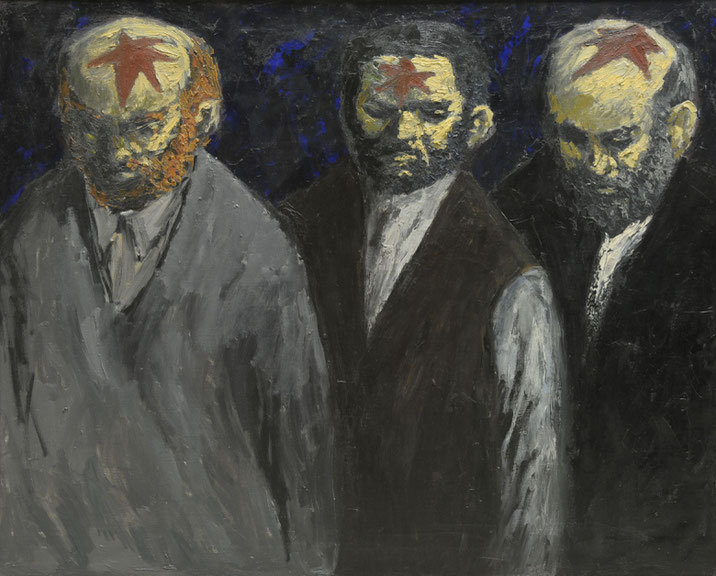Warsaw. Is it even worth discussing the current upsurge of fascist and far-right ideologies and politics with a prefix “post” along the lines of Enzo Traverso’s proposal for defining contemporary forms of fascism? The “post” is different from “neo” in neo-fascism or neo-reactionism, which are trying to perpetuate and regenerate themselves in the contemporary condition, refusing the contradictions of the past. Traverso argues that most of the latest right-wing movements are not neo-fascist, originating directly from historical fascism, but rather post-fascist 1: a variety of mutating ideologies that distinguish themselves from their precursors but at the same time turn racism, misogyny, and Islamophobia into new toxic forms of populism.
In the temporary pavilion on the shore of the Vistula, the Museum of Modern Art, a major Polish institution for modern and contemporary art, has opened an exhibition titled Never Again: Art against War and Fascism featuring around 20 historical and contemporary artists affiliated with antifascist and antimilitarist struggles. The exhibition tries, among other things, to revive the history of antifascism in close proximity to art practices by questioning the autonomous status of art and highlighting the connections between popular fronts, political activism, and artistic expression. The arrangement reflects this statement, with only a few of the artworks hung traditionally on the wall and the rest of them – paintings and graphic works, photographs and posters – displayed in wooden cases distributed around the space that perch on legs that can be adjusted separately to the physical parameters of the respective works. This makes it possible to displace them from neutrality and historical distance, and to create a demonstration-like situation in which the artwork, similar to a banner, confronts visitors.
The exhibition is relatively small in physical scale but is extremely consistent in the historical and conceptual sense. It showcases a selection of paintings and graphic works from the 1920 to 30s in Poland, most of them associated with the avant-garde Kraków Group. The works actively engage with left-wing struggles, depicting and referring to demonstrations, workers’ movements and strikes, police and prison violence. In the drawing Two Camps (Today) (1932) by Bronisław Wojciech Linke, the proletarians become one amorphous bio-political body comprising mouths, eyes, legs, and banners, with streams of slime coming out of orifices and straight onto the streets of struggle. An injured common body is not only a symbol of violence and suffering but is also the affective and bodily recomposition of solidarity and affinity.
The injured sick body violated by historical and contemporary fascism and seeking ways to recover and build opposition to extreme violence is the second keynote for the exhibition. Maja Berezowska, a painter who illustrated a series of caricatures on the sexual life of Adolf Hitler for the French magazine ICI Paris in the 1930s and became a prisoner in the terrifying women’s concentration camp in Ravensbrück, is represented with a series of drawings depicting the everyday life of her fellow inmates in the camp. Based on archival photographs, the painting Branded (1955) by Marek Oberländer features three men with red stars cut into their foreheads, referring to their Jewish origin as well as communist positions. In the postwar years, this artwork commemorated the Holocaust in opposition to the official Socialist Realist doctrine. Alina Szapocznikow condenses the horror of the violence and suffering into an abstract minimalist sculpture titled Exhumed (1955), where the body is metaphorically exhumed from the compressed layers of violent history. The dominant mode of representing the victory over fascism in the Stalinist Socialist Realism doctrine with its non-contradictory optimism is thus questioned here through both stylistic means and the scrutiny of non-heroic, mundane, silenced histories, figures, and subjects.
The best-known symbol of anti-war and anti-fascist resistance, Pablo Picasso’s Guernica, appears in several evocations in Never Again: in Dora Maar’s series of photographs tracing the creative process of producing the painting; as a copy that Wojciech Fangor made specifically for the 5th World Festival of Youth and Students held in Warsaw in 1955; and as a major reference in Goshka Macuga’s large-scale tapestry On the Nature of the Beast (2009), which alludes to the controversial speech made by Colin Powell on the necessity of the American invasion of Iraq against the backdrop of the anti-war symbol, this time covered in blue fabric. In the same manner, the selection of contemporary Polish and international art confronts contemporary forms of fascist politics – through criticism of the conjuncture of racism and the media apparatus (Martha Rosler and Alice Creischer), through investigation (by the collectives Forensic Architecture and The Society of Friends of Maxwell Itoya), and through counter-propaganda (Raymond Pettibon, Wolfgang Tillmans).
The terminological dispute on the prefixes “post” and “neo” does not concern another prefix – “anti” in antifascist. That one remains just as relevant as it was throughout the twentieth century, urgently demanding continued inquiry and a search for new forms of political and aesthetic expression.
[1] Enzo Traverso. The New Faces of Fascism: Populism and the Far Right. London and New York: Verso, 2019.
